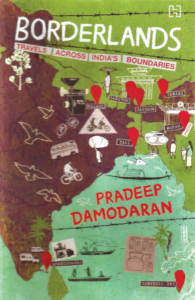Book review – Borderlands: Travels Across India’s boundaries
India Outbound
May-June 2017

Title: Borderlands: Travels Across India’s Boundaries, Author: Pradeep Damodaran, Pages: 388, Price: INR 650, Publisher: Hachette India, ISBN: 9789351950233
Thanks to better connectivity, cheaper air fare and higher disposable incomes, more and more Indians are travelling abroad as well as visiting domestic tourist circuits. However, travelling does not necessarily mean going on a holiday or flying to various exotic locales. It could also mean visiting borderlands, as this book reveals.
For most of us, visiting borders is a remote possibility. Forget planning a trip to these borderlands, most Indians would not even be aware of the existence of such places unless 24×7 television channels occasionally report the occurrence of some disaster or terror incidents. What’s worse is, when we think of borders it is only images of soldiers, army and shelling that come to our minds. We hardly give a thought to how ordinary people face various ordeals for their daily existence andsurvival.
Of course, India’s long borders are not only troubled but are all about dangerous living, conditioned either by nature’s fury or narrow political enmity and armed conflict. Yet, there are people living in India’s vast porous borders who carry on with their lives despite these trials and tribulations. Chennai-based journalist, Pradeep Damodaran, in his latest book, Borderlands: Travels Across India’s Boundaries, brings this experience to us, as he takes us to remote towns located near India’s vast boundaries.
The author has delved into his decades of experience in reportage, personal histories and travelogues to bring us face-to-face with this reality. He tries to raise the questions of national identity, citizenship and loyalty, which most of us, living in the mainland, take for granted. “Borderlands are usually those ambiguous spaces whose inhabitants find themselves trapped between two national identities,” writes Damodaran while introducing the book.
With a lot of debate, discussions and violence over national identities going on these days in the country, Borderlands will provoke you to think. “People living in the small towns that have sprung up along these borders are often uncertain about their nationality and do not always share that sense of belonging inherent in Indians living on themainland.”
Fascinated by an element of ambiguity in national identity, the author explores 10 borderlands in 10 different essays over 387 pages.
Recalling how India shares its maritime borders with at least 10 countries, Damodaran has documented life in Dhanushkodi (Tamil Nadu-Sri Lanka), Minicoy (Lakshadweep-Maldives), Hussainiwala (Punjab-Pakistan), Raxaul (Bihar-Nepal), Gangtok (Sikkim-China), Jaigaon (West Bengal-Bhutan), Tawang (Arunachal PradeshChina), Moreh (Manipur-Myanmar), the Indo-Bangladesh border trail, and Campbell Bay (Andaman and Nicobar-Thailand and Indonesia).
Despite the dichotomy, different communities in these border areas live in peace and harmony. The book begins with a visit to the once bustling fishing town of Dhanushkodi, which is located at the south-eastern tip of the Indian landscape, where the Indian Ocean meets the Bay of Bengal. It was decimated by a cyclone in 1964 and later local fishermen faced innumerable horrors on account of brutality by Sri Lankan security personnel.
Damodaran has maintained the natural flow while narrating the personal histories and tragedies, though he has offered a perspective to the problem wherever required.
The author chooses to write about Hussainiwala located at the Indo-Pakistan border in Punjab, instead of the famous Wagah Border. Much like the retreating event at the latter, Hussainiwala also stages a retreating event, albeit at a smaller scale.
Exploring Monpas and monasteries at Tawang in Arunachal Pradesh, sandwiched between India and its giant neighbour China, Damodaran was surprised to find that rice, lentils and parathas were the preferred food for most inhabitants.
As the author expresses his surprise over the ‘Indianness’ in the locals, to hotel owner Tenzin Dorjee, the latter asserts: “If there is ever a war between the two countries, every man in our community will stay and fight to defend India…”
While the book takes us through various regions of the country, the readers will not fail to notice a common thread — lack of infrastructure. Yet, life goes on though teetering on the edge.









